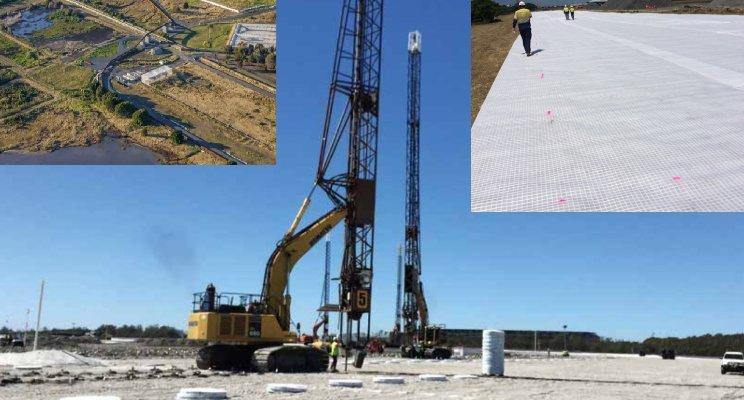The 2700 hectare Brisbane Airport precinct sits on an old river delta which contains an abundance of soft and waterlogged soil. Brisbane Airport Corporation (BAC) was looking for an economical yet technically and environmentally compatible solution to improve the bearing capacity of the very soft subgrade to build the new parallel runway. As the biggest aviation project in Australia, it is one of the largest infrastructure projects underway in Australia and will effectively double the capacity of Brisbane Airport.

To compress the soil and remove the water and build the new runway, around 11 million cubic metres of sand was sucked up from Moreton Bay and pumped and spread across 360 hectares of swamp and marshland at varying heights to achieve a suitably uniform ground settlement and compaction under the weight of the embankment.
As a part of dredging preparation, a 4.5km pipeline had to be built overland to the runway site crossing the luggage Point Waste Water treatment Plant land and the operational airfield at Brisbane Airport which are underlain by a very soft soil. To make this happen, geogrid reinforcements was considered by designers for construction of the 10m wide platform and access road. Combigrid geocomposite and Secugrid geogrid were selected to be used, as they have high radial stiffness at low elongations (0.5% strain) which leads to immediate confinement and reinforcement of the granular material, and a considerable increase in the granular layer stiffness, and control of the differential settlements. Over 150,000 m2 of Combigrid geocomposite and Secugrid geogrid were installed and covered with granular material to create the working platform and access roads.
To accelerate the consolidation, Ceteau vertical drains (wick drains) were then inserted into the ground over the site down to as deep as 35m. This will allow the moisture to be drawn from the soil more quickly than the action of gravity alone. Wick drains are installed in a grid pattern through a one-metre thick sand working platform. The reclamation work involved more than 330,000 (8,000,000 meters) of Ceteau wick drains installed spaced as close as 1m centres over the softest areas. The majority of settlements should be achieved by 2018.
Once finished in 2020, the Brisbane Airport Parallel Runway will contribute around $5 billion annually to the Queensland economy by 2035.
Please feel free to contact Amir Shahkolahi if you need more details on the geogrid reinforcement or wick drain design. amir@globalsynthetics.com.au
A useful video: https://www.youtube.com/watch?v=gTuCbSlNy7I

